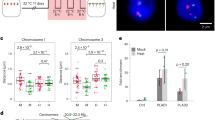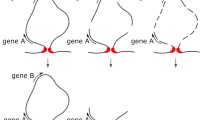Abstract
Two scaffold/matrix attachment regions (S/MARs), designated S/M I and S/M II, are located in the 5′-flanking region of the tobacco basic class I chitinase gene, CHN50. Structural analysis of these S/MARs showed that S/M II contained an intrinsically curved DNA sequence that is located between −1786 and −1722 relative to the initiation site of transcription. Electrophoretic mobility shift assays and southwestern blotting analysis were performed to identify the tobacco nuclear proteins that bind specifically to this curved DNA. These experiments revealed that nuclear proteins bound specifically to the curved DNA. Moreover, the nuclear proteins appeared to recognize the overall structure of the intrinsically curved DNA, as distinct from binding to the DNA with sequence specificity. Southwestern blotting analysis showed that proteins of 22, 24, 28 and 34 kDa bound specifically to the curved DNA. The possible functions of the binding proteins and their relationship to previously identified nuclear proteins, such as high-mobility-group proteins, are discussed.
Similar content being viewed by others
References
Atlung, T. and Ingmer, H. 1997. H-NS, a modulator of environmentally regulated gene expression. Mol. Microbiol. 24: 7–17.
Bechert, T., Heck, S., Fleig, U., Diekmann, S. and Hegemann, J.H. 1999. All 16 centromere DNAs from Saccharomyces cerevisiae show DNA curvature. Nucl. Acids Res. 27: 1444–1449.
Bianchi, M.E. 1988. Interaction of a protein from rat liver nuclei with cruciform DNA. EMBO J. 7: 843–849.
Bianchi, M.E., Falciola, L., Ferrari, S. and Lilley, D.M.J. 1992. The DNA binding site of HMG1 protein is composed of two similar segments (HMG boxes), both of which have counterparts in other eukaryotic regulatory proteins. EMBO J. 11: 1055–1063.
Bracco, L., Kotlarz, D., Kolb, A., Diekmann, S. and Buc, H. 1989. Synthetic curved DNA sequences can act as transcriptional activators in Escherichia coli. EMBO J. 8: 4289–4296.
Bradford, M.M. 1976. A rapid and sensitive method for the quantitation of microgram quantities of protein utilizing the principle of protein-dye binding. Anal. Biochem. 72: 248–254.
Camilloni, G., Caserta, M., Amadei, A. and Mauro, E.D. 1991. The conformation of constitutive DNA interaction sites for eukaryotic DNA topoisomerase I on intrinsically curved DNAs. Biochim. Biophys. Acta. 1129: 73–82.
Churchill, M.E.A., Jones, D.N.M., Glaser, T., Hefner, H., Searles, M.A. and Travers, A.A. 1995. HMG-D is an architecturespecific protein that preferentially binds to DNA containing the dinucleotide TG. EMBO J. 14: 1264–1275.
Collis, C.M., Molloy, P.L., Both, G.W. and Drew, H.R. 1989. Influence of the sequence-dependent flexure of DNA on transcription in E. coli. Nucl. Acids Res. 17: 9447–9468.
Fukuda, Y. 1997. Interaction of tobacco nuclear protein with an elicitor-responsive element in the promoter of a basic class I chitinase gene. Plant Mol. Biol. 34: 81–87.
Fukuda, Y. 1999. Characterization of matrix attachment sites in the upstream region of a tobacco chitinase gene. Plant Mol. Biol. 39: 1051–1062.
Fukuda, Y. and Shinshi, H. 1994. Characterization of a novel cisacting element that is responsive to a fungal elicitor in the promoter of a tobacco class I chitinase gene. Plant Mol. Biol. 24: 485–493.
Gartenberg, M.R., Crothers, D.M. 1991. Synthetic DNA bending sequences increase the rate of in vitro transcription initiation at the Escherichia coli lac promoter. J. Mol. Biol. 219: 217–230.
Grasser, K.D., Krech, A.B. and Feix, G. 1994. The maize chromosomal HMGa protein recognizes structural features of DNA and increases DNA flexibility. Plant J. 6: 351–358.
Green, P.J., Kay, S.A., Lam, E. and Chua, N-H. 1989. In vitro DNA footprinting. In: S.B. Gelvin, R.A. Schilperoort and D.P.S. Verma (Eds.) Plant Molecular Biology Manual, Kluwer Academic Publishers, Dordrecht, Netherlands, pp. B11: 1–22.
Griess, E.A., Grasser, K.D. and Feix, G. 1993. Repeat units from a maize rDNA external spacer region exhibit DNA curvature and interact with high-mobility-group proteins. Planta 191: 524–531.
Hagermann, P.J. 1990. Sequence-directed curvature of DNA. Annu. Rev. Biochem. 59: 755–781.
Hibino, Y., Nakamura, K., Tsukada, S. and Sugano, N. 1993. Purification and characterization of nuclear scaffold proteins which bind to a highly repetitive bent DNA from rat liver. Biochim. Biophys. Acta. 1174: 162–170.
Howard, M.T., Lee, M.P., Hsieh, T-S. and Griffith, J.D. 1991. Drosophila topoisomerase II-DNA interactions are affected by DNA structure. J. Mol. Biol. 217: 53–62.
Hughes, E.N., Engelsberg, B.N. and Billings, P.C. 1992. Purification of nuclear proteins that bind to cisplatin-damaged DNA, identity with high mobility group proteins 1 and 2. J. Biol. Chem. 267: 13520–13527.
Kim, J., Klooster, S. and Shapiro, D.J. 1995. Intrinsically bent DNA in a eukaryotic transcription factor recognition sequence potentiates transcription activation. J. Biol. Chem. 270: 1282–1288.
Kneidl, C., Dinkl, E. and Grummt, F. 1995. An intrinsically bent region upstream of the transcription start site of the rRNA genes of Arabidopsis thaliana interacts with an HMG-related protein. Plant Mol. Biol. 27: 705–713.
Laemmli, U.K. 1970. Cleavage of structural proteins during the assembly of the head of the bacteriophage T4. Nature 227: 680–685.
Lavigne, M., Herbert, M., Kolb, A. and Buc, H. 1992. Upstream curved sequences influence the initiation of transcription at the Escherichia coli galactose operon. J. Mol. Biol. 224: 293–306.
Lelong, J-C., Prevost, G., Lee, K. and Crepin, M. 1989. South western blot mapping, a procedure for simultaneous characterization of DNA binding proteins and their specific genomic DNA target sites. Anal. Biochem. 179: 299–303.
McAllister, C.F. and Achberger, E.C. 1989. Rotational orientation of upstream curved DNA affects promoter function in Bacillus subtilis. J. Biol. Chem. 264: 10451–10456.
Milot, E., Belmaaza, A., Wallenburg, J.C., Gusew, N., Bradley, W.E.C. and Chartrand, P. 1992. Chromosomal illegitimate recombination in mammalian cells is associated with intrinsically bent DNA elements. EMBO J. 11: 5063–5070.
Ohyama, T. 1996. Bent DNA in the human adenovirus type 2 E1A enhancer is an architectural element for transcription stimulation. J. Biol. Chem. 271: 27823–27828.
Paull, T.T., Carey, M. and Johnson, R.C. 1996. Yeast HMG proteins NHP6A/B potentiate promoter-specific transcriptional activation in vivo and assembly of preinitiation complexes in vitro. Genes Dev. 10: 2769–2781.
Pil, P.M. and Lippard, S.J. 1992. Specific binding of chromosomal protein HMG1 to DNA damaged by the anticancer drug cisplatin. Science 256: 234–237.
Pil, P.M., Chow, C.S. and Lippard, S.J. 1993. High-mobility-group 1 protein mediates DNA bending as determined by ring closures. Proc. Natl. Acad. Sci. USA 90: 9465–9469.
Pöhler, J.R.G., Norman, D.G., Bramham, J., Bianchi, M.E. and Lilley, D.M.J. 1998. HMG box proteins bind to four-way DNA junctions in their open conformation. EMBO J. 17: 817–826.
Snyder, M., Buchman, A.R. and Davis, R.W. 1986. Bent DNA at a yeast autonomously replicating sequence. Nature 324: 87–89.
von Kries, J.P., Phi-Van, L., Diekmann, S. and Strätling, W.H. 1990. A non-curved chicken lysozyme 50 matrix attachment site is 30 followed by a strongly curved DNA sequence. Nucl Acids Res. 18: 3881–3885.
Wada-Kiyama, Y. and Kiyama, R. 1994. Periodicity of DNA bend sites in human ɛ-globin gene region, possibility of sequencedirected nucleosome phasing. J. Biol. Chem. 269: 22238–22244.
Webster, C.I., Packman, L.C., Pwee, K-H. and Gray, J.C. 1997. High mobility group proteins HMG-1 and HMG-I/Y bind to a positive regulatory region of the pea plastocyanin gene promoter. Plant J. 11: 703–715.
Wu, H-M. and Crothers, D.M. 1984. The locus of sequence-directed and protein-induced DNA bending. Nature 308: 509–513.
Zahn, K. and Blattner, F.R. 1985. Sequence-induced DNA curvature at the bacteriophage λ origin of replication. Nature 317: 451–453.
Zappavigna, V., Falciola, L., Citterich, M.H., Mavilio, F. and Bianchi, M.E. 1996. HMG1 interacts with HOX proteins and enhances their DNA binding and transcriptional activation. EMBO J. 15: 4981–4991.
Zwilling, S., König, H. and Wirth, T. 1995. High mobility group protein 2 functionally interacts with the POU domains of octamer transcription factors. EMBO J. 14: 1198–1208.
Author information
Authors and Affiliations
Rights and permissions
About this article
Cite this article
Fukuda, Y. Interaction of nuclear proteins with intrinsically curved DNA in a matrix attachment region of a tobacco gene. Plant Mol Biol 44, 91–98 (2000). https://doi.org/10.1023/A:1006416929665
Issue Date:
DOI: https://doi.org/10.1023/A:1006416929665




